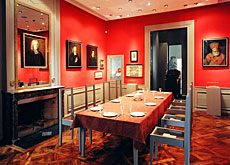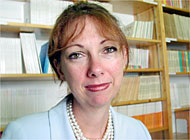Geneva museum reforms Calvinist image

The idea that John Calvin and his zealous Protestant reformists liked to let their hair down from time to time is probably, for most people, a leap of faith too far.
But it is difficult to come away from Geneva’s award-winning International Museum of the Reformation without thinking that there was more to this man of God and letters than meets the eye.
Housed in the Maison Mallet beside the city’s St Peter’s Cathedral where Calvin used to regale the faithful, the museum is the epitome of the phrase “small, but perfectly formed”.
And it is not just swissinfo that has been seduced by the museum’s charms: in December it picked up the Council of Europe Museum Prize for 2007 and is in the running for another European award.
The jury praised the museum’s international outlook and demonstration of religious tolerance, and described its attempt to bring theological discourse to life as “especially daring”.
Indeed it is this refreshing – and at times mischievous – approach to what is in many ways an austere subject that makes this temple of Protestantism and religion sing.
According to museum director Isabelle Graesslé, the intention has always been to bring the Reformation back to life, warts and all.
“Religion in general does not have a very positive image; people are afraid of it and see the damage it can cause,” she says. “Therefore people entering the museum are unsure what they are going to find.
“But during the course of their visit they come to realise – because we are not afraid to show the good and the bad – that you can also laugh at religion, the past and your ancestors. I think this helps to put this difficult and complex relationship into perspective.”
The Bible
It all starts in the “Bible Room” – “because everything begins with the Bible,” points out Graesslé – where rare versions are displayed.
They include one owned by Calvin’s disciple Theodore Beza, in which he has scribbled his thoughts in the margin like a lazy schoolboy. There is also a corner devoted to Luther – a recent addition, after a number of German visitors complained that their countryman was not being given enough prominence.
The early Protestants also had plenty to say about each other, as well as the state of the Church, and you can still catch Calvin and Luther verbal jousting in the grand salon.
A 15-minute audiovisual presentation on the Reformation from its momentous origins to the present begins with the two 16th-century protagonists appearing in mirrors on either side of the room.
Close by, Protestant caricatures poke fun at the “Pope from Hell”, while others take a humourous view of the divisions between Lutherans and Calvinists.
Reliving history
One of the recurring themes of the museum is to mix, as Graesslé puts it, the “big history with the small”.
Signed works by Calvin are interspersed with interactive displays showing how Geneva coped with the influx of Protestants that doubled the city’s population – by literally raising the roof.
In one room a collection of rare books and engravings charts the spread of the Reformation in France and the Wars of Religion; in another, visitors can take a pew and plug into a “Protestant jukebox” playing psalms and hymns.
One of the star turns is the Theological Banquet: a dining table is set for a fictional meal involving the likes of Calvin, Beza and the 18th-century philosopher Rousseau. Visitors can listen in as they debate the finer points of predestination.
Graesslé, who is both a Protestant pastor and theologian, is currently grappling with a tricky conundrum of her own: where to put the Council of Europe prize.
It is a bronze statuette by the Spanish artist Joan Miró, La femme aux beaux seins (The woman with beautiful breasts).
“We are thinking of perhaps putting it next to the statue of Calvin in the grand salon,” she says.
“I can’t imagine that he would be amused; but the more I find out about him, the more I discover an introvert who also had a sense of humour yet rarely had the time or the inclination to express it.”
swissinfo, Adam Beaumont in Geneva
The museum couldn’t be in a more symbolic place: the Maison Mallet was constructed nearly 300 years ago on the site of the cathedral’s former cloister where the people of Geneva chose to become Protestant in 1536.
Around two-thirds of visitors come from Switzerland, especially Geneva, and the remainder come from abroad, with a large proportion from France and the United States.
Museum director Isabelle Graesslé was the first woman Moderator of the Company of Pastors and Deacons in Geneva, a post created in 1541 by Jean Calvin.
Museum cost SFr4 million ($3.2 million) and opened April 2005.
It welcomed 25,000 visitors during its first year.
It operates on an annual budget of SFr700,000.
It will be Calvin’s 500th anniversary in 2009.

In compliance with the JTI standards
More: SWI swissinfo.ch certified by the Journalism Trust Initiative










You can find an overview of ongoing debates with our journalists here . Please join us!
If you want to start a conversation about a topic raised in this article or want to report factual errors, email us at english@swissinfo.ch.